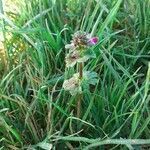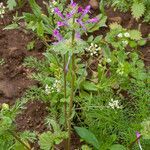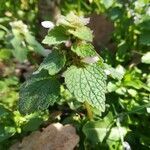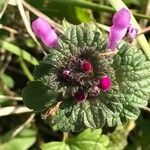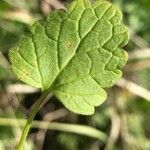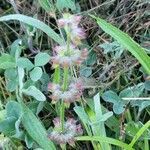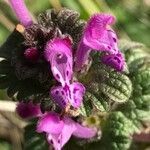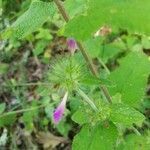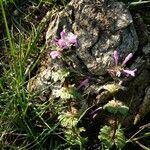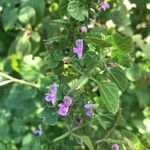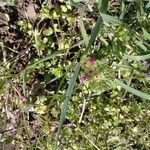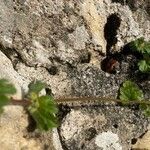Herbs annual or biennial. Stems to 30 cm, much branched at base, ascending, subglabrous. Upper leaves sessile; petiole of basal leaves at least as long as blade; leaf blade circular to reniform, 1-2 × 0.7-1.5 cm, sparsely strigose, base truncate to broadly truncate-cuneate, semi-clasping, margin deeply crenate to almost palmately lobed, apex rounded. Verticillasters 6-10-flowered; bracts ca. 4 × 0.3 mm, ciliate. Calyx tubular-campanulate, 4-5 × 1.7-2 mm, densely villous, glabrous except for white villous apically inside; teeth lanceolate-subulate, 1.5-2 mm, margin ciliate. Corolla purple-red or reddish, ca. 1.7 cm, puberulent; tube ca. 1.3 cm, throat ca. 3 mm wide, annulus absent; upper lip densely purple-red pubescent on outside, straight, oblong, ca. 4 mm, apex slightly curved; lower lip slightly longer; middle lobe obcordate, 2-lobulate. Filaments glabrous; anthers hirsute. Nutlets grayish yellow, obovoid, triquetrous, constricted at base, ca. 2 × 1 mm, white tuberculate. Fl. Mar-May, fr. Jul-Aug.
Annual herb with hairy or nearly glabrous, ± erect stems to c. 30 cm, but often < 5 cm high in dry situations. Petioles long and slender. Lamina 5-20 × 5-20 mm, ovate or oblong-ovate, crenate, sometimes more deeply cut, sparsely to moderately clothed in usually ± appressed hairs; base broad-cuneate, truncate to cordate. Bracts to c. 2.5 × 2 cm, very broadly ovate, hairy; base cordate, amplexicaul. Calyx 5-7 mm long, with ± silky tomentum; teeth linear-subulate, c. = tube. Corolla c. 15 mm long, pinkish purple; tube erect, narrow, long-exserted, glabrous inside; upper lip 3-5 mm long, tomentose outside, with 3 purple blotches inside; lateral lobes of lower lip 0 (sometimes fls cleistogamous and corolla remaining closed and included in calyx). Nutlets 1.8-2.2 mm long, patterned white, sharply angled.
Annual soft herb, freely branched from the base; stems ascending or decumbent, 0.1-0.3(-0.4) m long. Leaves petiolate; blade subrotund to reniform, 10-25 mm long and equally broad, sparingly to fairly densely pubescent, apex rounded, base cordate to truncate, margin coarsely and often deeply crenate or lobed; petiole 15-40 mm long. Inflorescence of 2-6 verticillasters, spaced below, crowded above; verticillasters 3-10-flowered; bracts clasping, broader than long, resembling the leaves. Calyx villous, 6 mm long, 5-toothed; teeth lanceolate-subulate, 2.5 mm long, not spinescent. Corolla purple to whitish, 15-16 mm long in normal flowers (cleistogamic flowers much shorter); tube slender, 9-11 mm long, exannulate; upper lip 4-5 mm long; lower lip 3 mm long. Nutlets smooth, often mottled, 2 mm long.
Annual or perennial, soft herb, 0.1-0.4 m high, freely branched from base; stems ascending or decumbent. Leaves petiolate, subrotund to reniform, base cordate to truncate, apex rounded, margins coarsely and deeply crenate or lobed. Inflorescences: 2-6 verticils, spaced below, crowded above; verticillasters 3-10-flowered; bracts clasping. Flowers: purple to whitish. Calyx villous, 5-toothed; teeth lanceolate-subulate. Corolla bilabiate; tube slender, dilated towards mouth; upper lip ascending, concave; lower lip spreading or deflexed. Style 2-lobed. Flowering time Mar.-Sept. Fruit smooth, oblong nutlets.
Annual herb, 100-400 mm high. Leaves petiolate; blade subrotund to reniform, 10-25 mm long, apex rounded, base cordate to truncate, margins coarsely and deeply crenate or lobed; petioles 15-40 mm long. Flowers: in 2-6 verticillasters, spaced below, crowded above, verticillasters 3-10-flowered; bracts clasping, resembling leaves; calyx 6 mm long, 5-toothed, teeth narrowly ovate-subulate, 2.5 mm long, not spinescent, villous; corolla 15-16 mm long, purple to whitish; Mar.-Sep.
An annual herb. The stems can be 30 cm long. The stems have many branches. The upper leaves do not have stalks but lower leaves have stalks as along as the leaf blade. The leaf blade is round or kidney shaped. It is 1-2 cm long by 0.7-1.5 cm wide. The edges are irregular or lobed and the base partly clasps the stem. There are 6-10 flowers in a head. They occur in rings in the axils of the leaves and are pink. The nuts are greyish yellow and oval. They are 3 angled.
